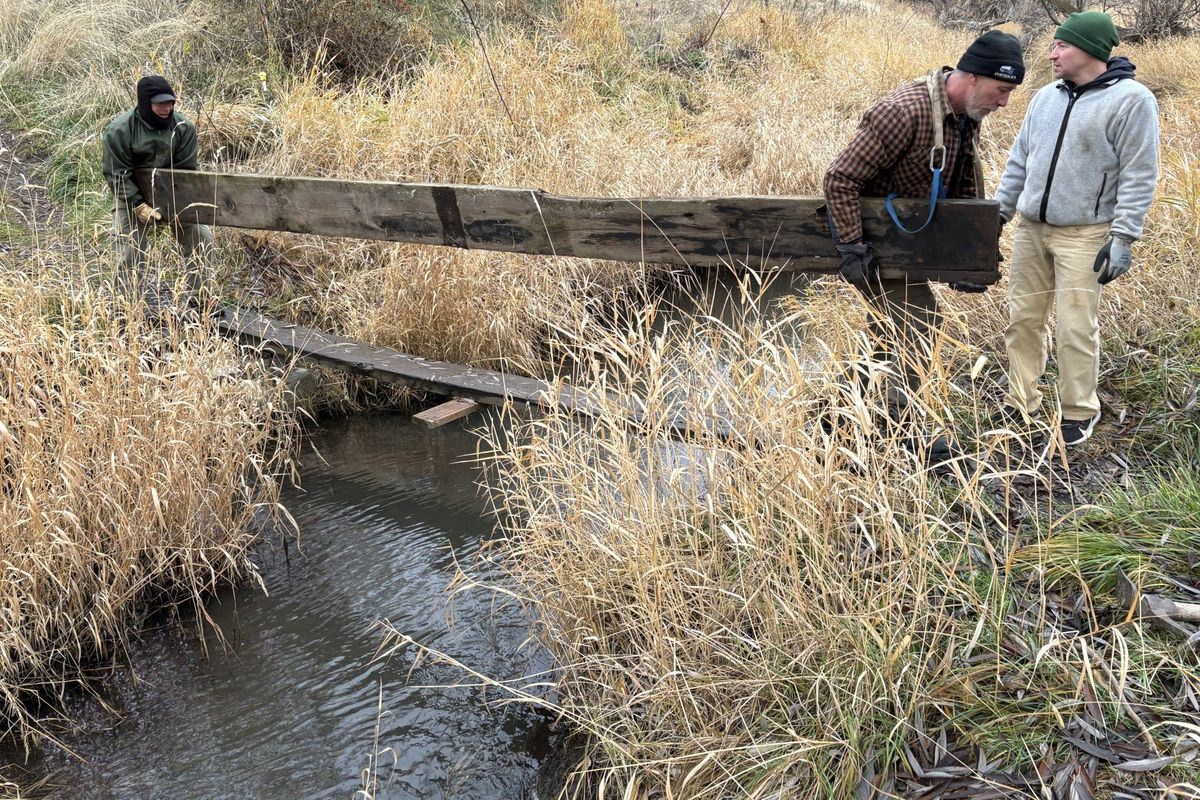Back to nature in the heart of the city

If Washington State University is the beating heart of Pullman, then the South Fork of the Palouse River is its circulatory system. The river is joined on the east end of town by Paradise Creek and on the north end by Missouri Flat Creek. That’s three forks, which is significant because before it was called Pullman, the town was known as Three Forks.
There are some lovely walking trails along the South Fork, most of which are below street level. They are wooded, sheltered, and pleasant. Beaver, great blue heron and other critters are common.
Six pedestrian bridges cross the South Fork and its tributaries, each built with heavy wooden planks. For years, a local curmudgeon has been installing these bridges in the spring and removing them every fall, lest they be swept away by high water.
The curmudgeon is 80 now, so a small cadre of trail users lends a hand with the installation and removal of the bridges. On a raw and gusty day in early December, the group gathered near the confluence of Paradise Creek and the South Fork to pull the planks.
The brains of the operation
The bridges are the brainchild of Scotty Cornelius, a hearty cyclist, canoeist, and backcountry skier who once climbed “The Nose” route on El Capitan in Yosemite National Park. In his professional life, he spent 38 years with the geology department at WSU before retiring. Though he presents a gruff exterior, Cornelius is not technically a curmudgeon; “crusty yet benign, with a heart of gold” is a better description.
Sometime around 2008, Cornelius acquired a stack of long, thick wooden planks from a local farmer who was rebuilding a private bridge over the South Fork. The planks still had plenty life in them, and the seeds for the South Fork trail system began to take root.
In addition to the planks, Cornelius also owns a big, funky mower for cutting canary grass which, left unchecked, renders the trails impassable in summer.
Many hands make light work
All six of the volunteers who showed up to pull the planks on a chilly December morning had their reasons.
“I walk a lot, and my goal is to be in as many undeveloped places around town as possible,” said Bill Kabasenche, a professor in WSU’s School of Politics, Philosophy and Public Affairs. “It helps me get to know the community and get to know the land.
“It keeps my soul alive.”
With that, Kabasenche turned a single bridge plank on edge, then lifted it from its cinderblock abutment. As Kabasenche dragged it away, one of the other volunteers stooped to pick up the trailing end. With the plank firmly under control, the pair carried it up the muddy embankment to a beat-up old pickup.
At the other end of the plank, Brian French, who is a Regents professor in WSU’s College of Education, noted, “These trails are the only place in the city where it feels like you’re not in the city.
“You’re not on a sidewalk and you can’t hear the traffic,” French said. “It’s a great place for adventure walks with kids.”
Kabasenche and French are professional educators, and both note that studies show students perform better on standardized tests when they get regular exposure to nature.
A little goes a long way
The South Fork trail system isn’t very large, maybe a mile at the most. In this respect it is similar to what Henry David Thoreau described in his classic 1854 book about living simply on the shores of Walden Pond, near Concord, Massachusetts.
Like Walden Pond, urban trails along the South Fork of the Palouse are not deep wilderness with a capital “W.” Instead, they offer a little bit of wildness, an oasis of peace near a bustling town. It’s an easy escape, and a quick connection to the succoring constancy of nature. For those who visit, it is a tonic to the soul.
For Thoreau, 170 years ago, the charms of simple living near a quiet pond were all he needed to recharge his batteries.
For residents of Pullman, the South Fork trails hold the same appeal.
Never one to sit still, Cornelius is always looking to bring more trails into existence. He owns an odd parcel of land nestled between Pullman’s middle school and Dry Fork Creek that is laced with trails, all of which are open to the public. He even commissioned signs that resemble the city of Pullman’s official park signs, welcoming visitors to his Dry Fork Creek Natural Area.
There’s no question that Cornelius is the Johnny Appleseed of public trails in Pullman, but his polyglot band of helpers is essential for transforming a vision into reality. Every year in late November or early December, they neatly stack the planks in a fenced compound behind a furniture store; the store’s owner graciously grants permission. Every year around Mother’s Day, they return the planks to the river and reset the bridges for another season of use.
This year, the entire removal process took little more than an hour. There was a lot of laughing and good-natured ribbing, so the time passed quickly. Pulling the planks was a labor of love, so it never felt like work.
“If you use something, you have a responsibility to take care of it,” French said as the group prepared to leave. “I use these trails every day, so I’m happy to do it.”
The other volunteers nodded as French spoke because, along the South Fork, all hearts beat with the pulse of the river.